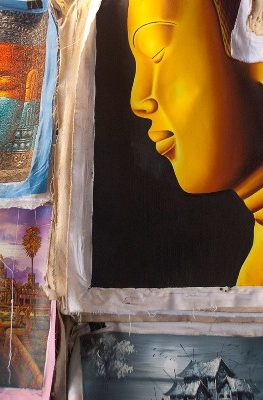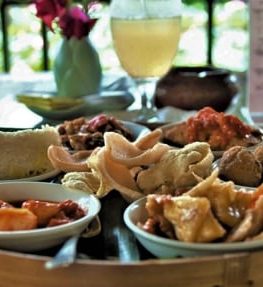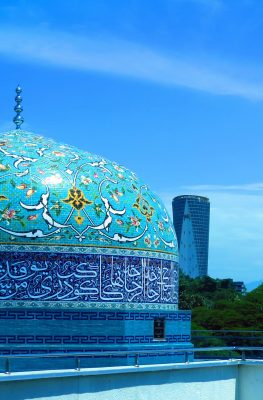Published on October 10, 2017

What’s the point in visiting Southeast Asia’s temples, mansions and fortresses, if you can’t share photos of your time there on social media? And what’s the point of even sharing your snaps if you can’t take good ones in the first place?
Now, you don’t have to have Estan Cabigas‘ eye for architecture to take compelling photos of the local buildings. For starters, Estan has years of practice on the average tourist, having made a career of architectural photography since 2003.
That year, “I started documenting Spanish colonial era churches and related structures in the Philippines, a consequence of visiting a northern town and found out that the once majestic and ancient church burned a month before my visit,” Estan explains. “This personal work landed me my first coffee table book.”
Estan needed little convincing after that to resign his day job as a telecoms engineer and make a living instead shooting buildings.
Since then, Estan has embarked on a wide-ranging photography career, with five coffee table books, two blogs and more magazine layouts, exhibitions and festivals than he can count. We asked him about looking at Southeast Asia from a traveling photographers’ perspective – and he had plenty to tell us.
Q: What cities in Southeast Asia do you find the most “photographable”/fun to shoot for their architecture?
As of now, I’m very much interested with Art Deco, in fact, I have been documenting structures built in this architectural style. Art Deco is short for Arts Decoratifs, from an event in Paris held in 1925, the Exposition Internationale des Arts Décoratifs et Industriels Modernes. It peaked in the 30s, gradually transformed into Streamline Moderne in the 40s and waned after that but some were still built in the 1950s. Art Deco swept the world and Southeast Asia wasn’t spared. Asian architects adapted and adopted the style, infusing it with local elements that sometimes its called Tropical Asian Art Deco.
For the best examples, two cities stand out: Iloilo City in the Philippines and Bandung in Indonesia.
Find out more about the Philippines’ Baroque churches.

Q: Any personal discoveries/surprises that you can tell us about any of these cities?
Iloilo is one of my favorite cities in the Philippines. Beyond the good food and Spanish colonial architecture, it has one of the country’s best preserved and well maintained Art Deco structures compared to Manila which were mostly lost due to World War II and neglect in modern times.
From stunning mansions in Jaro District to commercial buildings, a theater and market in Iloilo Downtown and even the cemetery of Molo District, Art Deco is very much alive and part of the city’s cultural and architectural fabric. The Lopez Boathouse is one such gem that you have to see. At the Molo Cemetery, the entrance arch and gate is in this architectural style while the big Spanish colonial era cemetery, renovated in the 20th century, sports an art deco facade.
I got to visit Bandung in Indonesia once, a sidetrip I made after a bloggers’s famtour last year. When you speak of Art Deco in Southeast Asia, Bandung is often cited. Much of the city’s structures were built during the Art Deco period and it’s an Art Deco lover’s paradise.
Walking the main and even side streets, you are bound to encounter an Art Deco structure. Jalan Asia Afrika is such: Hotel Grand Preanger, Hotel Bidakara Grand Savoy-Homann, the Gedung Merdeka are just a few of several. Along Jalan Braga, the most interesting is the De Majestic theater. There’s also Gedung Sate, the seat of the governor, with design incorporating Indonesian elements. But I think, the crowning glory of Bandung Art Deco is the stunning Villa Isola, a sumptuous architectural gem.
Find out more about traveling overland through Java, stopping at Bandung along the way.
Q: What architectural styles do you look for/find most often when you go around the cities in the region?
First and foremost, I look for Art Deco architecture. Whenever I am visiting a southeast asian city, I always do research first on what art deco structures are present. If I can’t find these online, I usually do walks in the old Quarter. Other styles like Brutalist, Modernist, 50s/60s, native/indigenous and colonial follow.

Q: Any photography tips you can share for the first-time traveler to Southeast Asia looking to shoot the local buildings?
Shooting Architecture can be demanding in terms of gear and patience. But the following should be a good guide:
- a wide angle lens is perfect. Old buildings are usually in city centers or downtown areas where space can be tight. With a wide angle lens, or ultra wide angle lens, which I usually bring with me, you can shoot the building better.
- shoot during specific times. I don’t usually shoot between 10 AM and 2 PM. Early morning and late afternoon are best when the light is good. You should also see to it that the part you are shooting is not under the sun’s shadow.
- a tripod for night shots or long exposures is advisable
- although I particularly prefer shooting Architecture without people, you need to have lots of patience to achieve this. You have to wait for people to disappear from the frame or come back some other time because cars or other vehicles are parked infront of the structure. But consider also incorporating people into the photo to give it scale or to show the Architecture’s relationship to the place and its people
- other than getting the whole structure in the frame, try shooting details or patterns. Play with contrasts and shadows.
* * * * *
Estan’s newest projects can be found on two different sites: Langyaw (http://langyaw.com), where he blogs on travel; and TenZeroFour (http://tenzerofour.com) where he chronicles his architectural finds. Follow Estan on his social media profiles on Twitter and Instagram.





